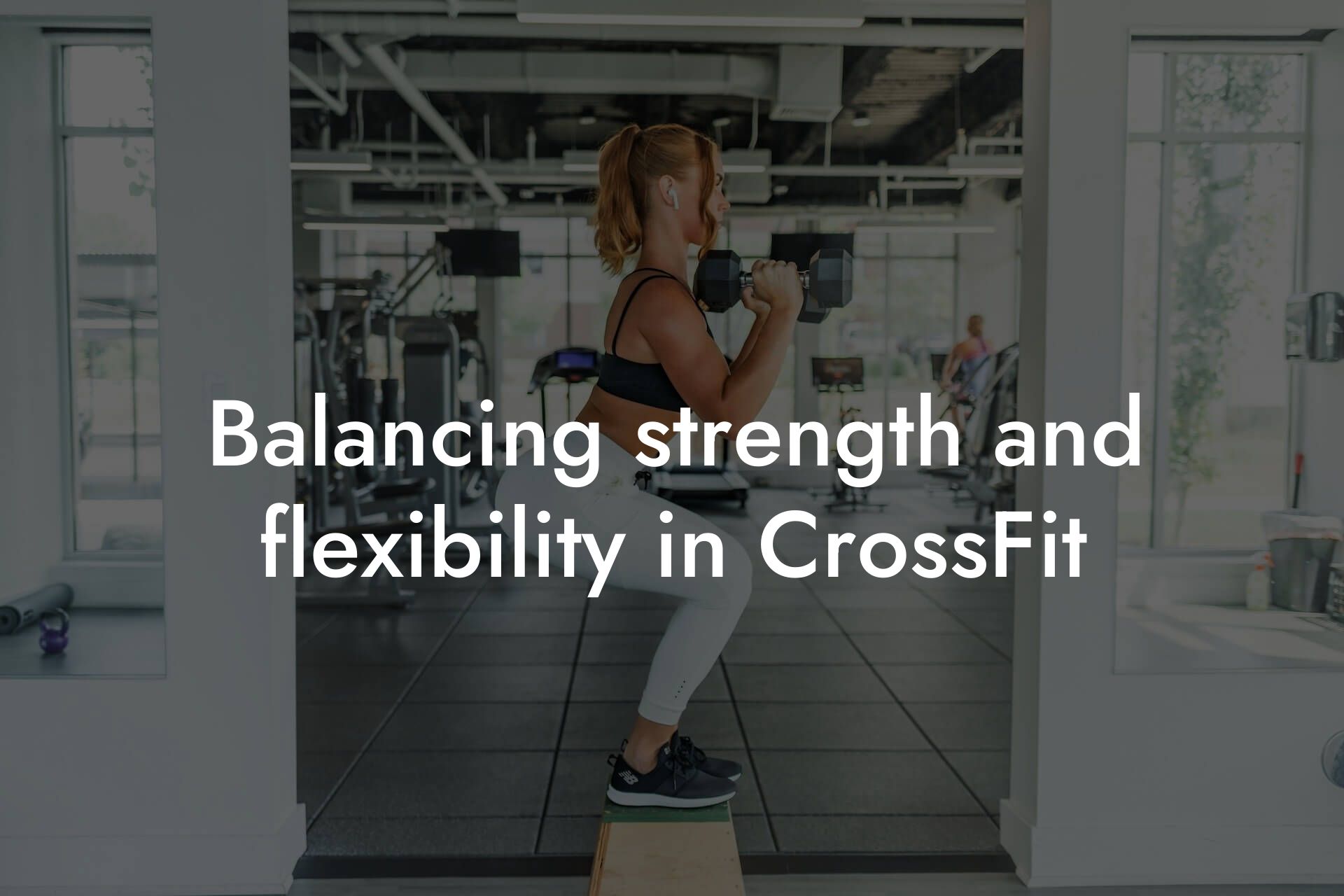As a high-earning professional, you understand the importance of physical performance in achieving your goals. CrossFit competitions, in particular, require a unique blend of strength, power, and endurance. In this article, we'll delve into the world of endurance training, providing you with a comprehensive guide to improve your performance in CrossFit competitions.
Table of Contents
- What is Endurance in CrossFit?
- Why is Endurance Important in CrossFit Competitions?
- Assessing Your Current Endurance Level
- Building Endurance for CrossFit Competitions
- Nutrition and Recovery for Endurance
- Mental Preparation for Endurance
- Periodization and Programming for Endurance
- Frequently Asked Questions
What is Endurance in CrossFit?
In the context of CrossFit, endurance refers to the ability to sustain a high level of intensity over a prolonged period. It's the capacity to perform multiple exercises, at maximum effort, without succumbing to fatigue. Endurance is a critical component of CrossFit competitions, as it allows athletes to complete workouts efficiently and effectively.
Why is Endurance Important in CrossFit Competitions?
Endurance is essential in CrossFit competitions because it enables athletes to:
• Perform high-intensity exercises for extended periods
• Recover quickly between exercises and rounds
• Maintain a high power output throughout the workout
• Reduce the risk of injury and burnout
Assessing Your Current Endurance Level
Before you begin training, it's essential to assess your current endurance level. This will help you identify areas for improvement and track your progress over time. At Tano Performance Group, we use our state-of-the-art DEXA machine to provide a comprehensive body assessment, including measurements of body fat, muscle mass, and bone density. This information will help you understand your current fitness level and create a personalized training plan.
Building Endurance for CrossFit Competitions
To improve your endurance for CrossFit competitions, focus on the following training strategies:
• Cardiovascular Training: Incorporate cardio exercises such as running, cycling, or rowing into your training routine. Aim for 20-30 minutes of moderate-intensity cardio, 2-3 times a week.
• High-Intensity Interval Training (HIIT): Incorporate HIIT workouts into your routine, focusing on exercises like burpees, jump squats, and box jumps. These exercises will help improve your anaerobic endurance and increase your power output.
• Strength Training: Building strength in your muscles will help you maintain a high power output during workouts. Focus on exercises like squats, deadlifts, and bench press to improve your overall strength.
• Endurance-Specific Exercises: Incorporate exercises that mimic the demands of CrossFit competitions, such as AMRAPs (as many rounds as possible) and chipper workouts.
Nutrition and Recovery for Endurance
A well-structured nutrition plan and recovery strategy are crucial for improving endurance. Focus on:
• Carbohydrate Loading: Increase your carbohydrate intake 2-3 days before competition to ensure you have adequate energy stores.
• Hydration: Drink plenty of water before, during, and after workouts to prevent dehydration and maintain performance.
• Protein Intake: Consume 1.2-1.6 grams of protein per kilogram of body weight to aid in muscle recovery and growth.
• Rest and Recovery: Ensure you get 7-9 hours of sleep each night and take rest days as needed to allow your body to recover.
Mental Preparation for Endurance
Mental preparation is a critical component of endurance training. Focus on:
• Positive Self-Talk: Develop a positive mindset by focusing on your strengths and accomplishments.
• Visualization: Visualize yourself performing well in competitions, overcoming obstacles, and pushing through fatigue.
• Breathing Techniques: Practice deep breathing exercises to help manage stress and maintain focus during workouts.
Periodization and Programming for Endurance
To avoid plateaus and prevent overtraining, it's essential to periodize your training and programming. Focus on:
• Macro-Cycles: Divide your training into macro-cycles, focusing on specific goals and training phases.
• Meso-Cycles: Divide your macro-cycles into meso-cycles, focusing on specific training blocks and exercises.
• Micro-Cycles: Divide your meso-cycles into micro-cycles, focusing on daily training sessions and exercises.
By incorporating these training strategies, nutrition and recovery plans, and mental preparation techniques, you'll be well on your way to improving your endurance for CrossFit competitions. Remember to stay consistent, patient, and focused, and you'll see significant improvements in your performance.
Frequently Asked Questions
What is endurance in the context of CrossFit competitions?
Endurance in CrossFit competitions refers to the ability to sustain a high level of intensity over a prolonged period of time. It encompasses cardiovascular endurance, muscular endurance, and mental toughness, allowing athletes to perform at their best throughout the competition.
Why is endurance important for CrossFit competitions?
Endurance is crucial for CrossFit competitions because it enables athletes to recover quickly between exercises, maintain a high pace throughout the workout, and push through fatigue. A strong endurance base allows athletes to perform at a higher intensity, which can be the difference between winning and losing.
How can I improve my endurance for CrossFit competitions?
Improving endurance for CrossFit competitions requires a well-structured training program that incorporates cardiovascular exercise, strength training, and high-intensity interval training (HIIT). Additionally, proper nutrition, recovery strategies, and mental preparation are essential for building endurance.
What are some effective cardiovascular exercises for improving endurance?
Effective cardiovascular exercises for improving endurance include running, rowing, swimming, cycling, and high-intensity interval training (HIIT) using exercises like burpees, jump squats, and box jumps. These exercises improve cardiovascular fitness, increase lung function, and enhance muscular endurance.
How often should I train to improve my endurance?
To improve endurance, it's recommended to train 3-4 times per week, with at least one or two rest days in between. This allows for adequate recovery time and enables the body to adapt to the demands of high-intensity training.
What is the importance of strength training for endurance?
Strength training is essential for building endurance because it increases muscular power and endurance, allowing athletes to generate more force and speed during exercises. Stronger muscles also reduce the risk of injury and improve overall athletic performance.
How can I incorporate strength training into my endurance program?
Strength training can be incorporated into an endurance program by adding exercises like squats, deadlifts, bench press, and rows to your workout routine. Aim to do strength training exercises 2-3 times per week, focusing on compound exercises that work multiple muscle groups at once.
What is high-intensity interval training (HIIT), and how can it improve endurance?
HIIT involves short bursts of high-intensity exercise followed by brief periods of rest. This type of training improves endurance by increasing anaerobic capacity, speed, and agility, allowing athletes to perform at a higher intensity for longer periods.
How can I incorporate HIIT into my endurance program?
HIIT can be incorporated into an endurance program by adding exercises like sprints, burpees, jump squats, and box jumps to your workout routine. Aim to do HIIT workouts 2-3 times per week, with 3-5 minutes of high-intensity exercise followed by 1-2 minutes of rest.
What role does nutrition play in improving endurance?
Nutrition plays a critical role in improving endurance by providing the body with the necessary fuel to perform at a high intensity. A balanced diet that includes complex carbohydrates, lean protein, and healthy fats helps to optimize energy production and support recovery.
What are some key nutrients for improving endurance?
Key nutrients for improving endurance include complex carbohydrates, lean protein, healthy fats, and electrolytes like sodium, potassium, and magnesium. These nutrients help to optimize energy production, reduce inflammation, and support recovery.
How can I optimize my recovery strategies to improve endurance?
Optimizing recovery strategies involves getting adequate sleep, stretching, foam rolling, and using techniques like compression garments and cryotherapy to reduce inflammation and promote recovery. Proper recovery strategies help to reduce muscle soreness, improve performance, and enhance endurance.
What is the importance of mental preparation for improving endurance?
Mental preparation is essential for improving endurance because it helps athletes to develop a strong mindset, overcome obstacles, and push through fatigue. Techniques like visualization, positive self-talk, and breathing exercises can help to improve mental toughness and enhance endurance.
How can I incorporate mental preparation into my endurance program?
Mental preparation can be incorporated into an endurance program by practicing techniques like visualization, positive self-talk, and breathing exercises during workouts. Additionally, setting realistic goals, tracking progress, and celebrating small victories can help to build confidence and mental toughness.
What are some common mistakes to avoid when training for CrossFit competitions?
Common mistakes to avoid when training for CrossFit competitions include overtraining, inadequate recovery, poor nutrition, and lack of mental preparation. These mistakes can lead to burnout, injury, and poor performance.
How can I avoid overtraining and prevent burnout?
Avoiding overtraining and preventing burnout involves listening to your body, taking rest days as needed, and incorporating recovery strategies into your training program. Additionally, setting realistic goals, tracking progress, and celebrating small victories can help to reduce stress and prevent burnout.
What are some effective strategies for managing competition day nerves?
Effective strategies for managing competition day nerves include visualization, positive self-talk, deep breathing exercises, and focusing on the process rather than the outcome. Additionally, having a pre-competition routine, such as listening to music or doing light cardio, can help to calm nerves and prepare for the competition.
How can I stay motivated and focused during a long CrossFit competition?
Staying motivated and focused during a long CrossFit competition involves setting small goals, tracking progress, and celebrating small victories. Additionally, having a support team, such as coaches and teammates, can help to provide encouragement and motivation during the competition.
What are some key takeaways for improving endurance for CrossFit competitions?
Key takeaways for improving endurance for CrossFit competitions include incorporating cardiovascular exercise, strength training, and HIIT into your training program, optimizing nutrition and recovery strategies, and developing a strong mental game. By following these principles, athletes can improve their endurance and perform at their best during CrossFit competitions.
How can I get started with improving my endurance for CrossFit competitions?
Getting started with improving endurance for CrossFit competitions involves setting realistic goals, developing a well-structured training program, and incorporating nutrition and recovery strategies into your daily routine. Additionally, seeking guidance from a qualified coach or trainer can help to provide personalized feedback and support.
What are some additional resources for improving endurance for CrossFit competitions?
Additional resources for improving endurance for CrossFit competitions include online training programs, CrossFit gyms, and fitness professionals who specialize in endurance training. Additionally, reading books and articles, watching videos, and attending seminars can provide valuable insights and tips for improving endurance.
How can I track my progress and measure my endurance?
Tracking progress and measuring endurance can be done by monitoring workout times, tracking heart rate and pace, and assessing overall performance during workouts. Additionally, using tools like fitness trackers and heart rate monitors can provide valuable data to track progress and measure endurance.
What are some common misconceptions about endurance training for CrossFit competitions?
Common misconceptions about endurance training for CrossFit competitions include the idea that endurance training is only for distance athletes, that strength training is not important for endurance, and that recovery strategies are not necessary. These misconceptions can lead to ineffective training programs and poor performance.
How can I stay safe and injury-free during endurance training for CrossFit competitions?
Staying safe and injury-free during endurance training for CrossFit competitions involves listening to your body, taking rest days as needed, and incorporating recovery strategies into your training program. Additionally, proper warm-up and cool-down routines, as well as using proper form and technique during exercises, can help to reduce the risk of injury.
Here are some related articles you might love...
- The role of body composition in CrossFit performance
- Nutrition strategies for CrossFit athletes
- Balancing strength and flexibility in CrossFit
- How DEXA scans can benefit CrossFit enthusiasts
- The importance of muscle recovery in CrossFit
- How to maintain bone density with CrossFit training
- Strength training tips specific to CrossFit workouts
- Preventing injuries in CrossFit: A comprehensive guide
- Reducing body fat for better CrossFit performance
Zak Faulkner
Zak Faulkner is a leading authority in the realm of physical health and body composition analysis, with over 15 years of experience helping professionals optimise their fitness and well-being. As one the experts behind Tano Performance Group, Zak has dedicated his career to providing in-depth, science-backed insights that empower clients to elevate their physical performance and overall health.
With extensive knowledge of DEXA technology, Zak specializes in delivering comprehensive body assessments that offer precise data on body fat, muscle mass, bone density, and overall physique. His expertise enables individuals to make informed decisions and achieve their fitness goals with accuracy and confidence. Zak’s approach is rooted in a deep understanding of human physiology, combined with a passion for helping clients unlock their full potential through personalised strategies.
Over the years, Zak has earned a reputation for his commitment to excellence, precision, and client-focused service. His guidance is trusted by top professionals who demand the best when it comes to their health. Whether advising on fitness programs, nutritional strategies, or long-term wellness plans, Zak Faulkner’s insights are a valuable resource for anyone serious about taking their health and fitness to the next level.
At Tano Performance Group, Zak continues to lead our Content Team revolutionising how professionals approach their physical health, offering unparalleled expertise that drives real results.




